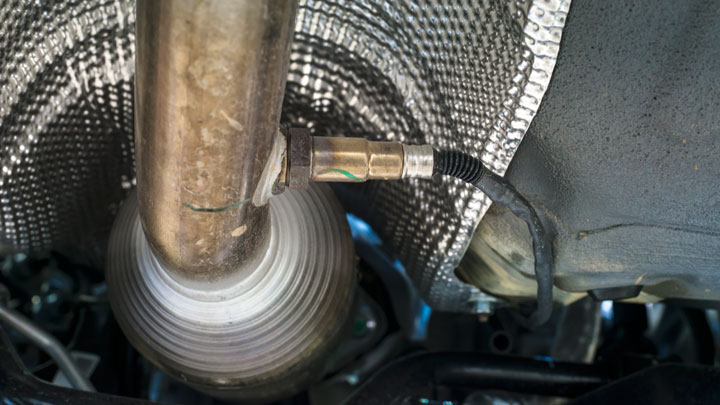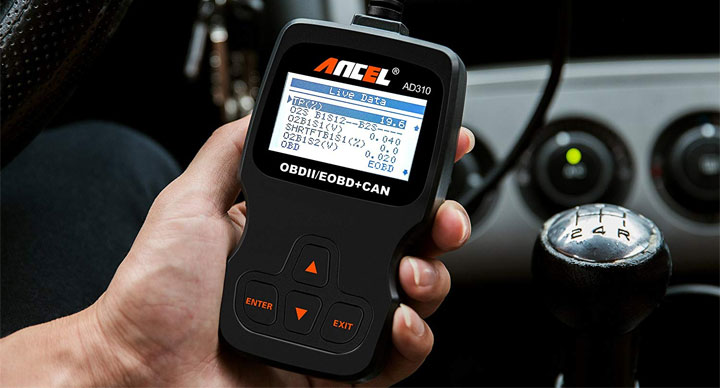P0158 Code (Symptoms, Causes, and How to Fix)
When you’re driving down the road and the check engine light turns on, it sends your heart right into your throat. It’s a common response, but unfortunately it’s also a common problem.
You rush off to figure out what the code means, but even then it only tells you so much. What exactly is a code P0158, is it a big deal, and how do you get it to go away?

What Does Code P0158 Mean?
Once you read the check engine light that still only tells you so much. What does an “O2 Sensor Circuit High Voltage” message really mean anyways?
The O2 sensor circuit refers to the oxygen sensor circuit in your vehicle. There’s an oxygen sensor both before (sensor #1) and after (sensor #2) the catalytic converter and they measure the effectiveness of the catalytic converter and the number of harmful emissions reaching the atmosphere.
Related: Bank 1 vs Bank 2 Meaning
The PCM will use these measurements to fine-tune engine performance and it’s a necessary component to pass an emissions test.
A code P0158 tells you that an area of that circuit has too much voltage. This is common when there’s a short in the system, but it could also mean that the system is pushing too much fuel through the exhaust. Either way, the reading in the circuit is too high, and it’s the reason there’s a check engine light on!
Related: P0153 Code, P0154 Code, P0155 Code, P0157 Code
Symptoms of Code P0158
If your vehicle has a code P0158, there’s a good chance you’ll notice a few other symptoms. Of course, you’re going to have a check engine light, but there’s also a pretty good chance it’ll have a rougher idle than normal.
It’s also possible for you to notice either a slight or a significant drop in fuel efficiency, and rarely, a code P0158 can lead to the engine dying outright.
It’s also possible, but equally rare that the only adverse condition you’ll notice is a check engine light! It all depends on what the source of the code P0158 is, so pay special attention to any symptoms that match up. As with other DTCs, the more symptoms that are present, the higher the probability it’s your main issue.
- Check engine light
- Rough idle
- Drop in fuel economy
- Engine dies
- No adverse conditions
Causes of Code P0158

While a code P0158 is pretty straightforward, there are quite a few potential causes. The most likely cause is a defective oxygen sensor. If the oxygen sensor shorts out when it fails, you can end up with a code P0158.
Other potential causes include a defective oxygen sensor heater circuit, excessive fuel pressure, wiring issues, or even a faulty engine coolant temperature sensor!
Finally, while it’s unlikely, it is possible that your vehicle has a code P0158 because of a PCM that needs an update or a completely defective PCM.
- Defective oxygen sensor
- Defective oxygen sensor heater circuit
- High fuel pressure
- Faulty engine coolant temperature sensor
- Wiring problems
- Outdated/defective PCM
Is Code P0158 Serious?
If a code P0158 is a serious problem all comes down to the reason behind the code in the first place. If it came on because of a defective oxygen sensor, it’s not a huge deal, but if it’s on because of excessive fuel pressure, it can quickly lead to more severe engine damage.
Without knowing the exact cause of the code you’re taking a risk with your engine, and it’s not a risk we would recommend taking.
Even if you get lucky and the code P0158 is there for a minor reason like a defective oxygen sensor, now your vehicle has no way to tell you if something more serious comes up. It’s best to fix the check engine light as soon as possible to ensure nothing else comes from it.
How to Fix

If your vehicle has a code P0158 the first thing you want to know is how to fix it. While having an automotive scan tool will make things a lot easier for you since you can see the readings from each sensor, there are some basic troubleshooting tricks you can use to rule a few simple things out.
#1 – Use Symptoms to Pinpoint the Problem
First, try to figure out if there are any other symptoms present with the check engine light. If there’s a significant drop in fuel, it’s likely that there’s just too much fuel pressure. If the engine dies you can also rule out some of the simpler fixes like a defective oxygen sensor or a faulty engine coolant temperature sensor.
#2 – Check Voltage at Oxygen Sensors
If you have a multimeter but no automotive scan tool, we recommend checking the reading going into and leaving both oxygen sensors on your vehicle. If the reading is right going into the oxygen sensor but the output is wrong, there’s a good chance you have a faulty oxygen sensor.
#3 – Get Professional Help
If you don’t notice anything abnormal with the oxygen sensor readings, we recommend reaching out to a professional shop or finding your own automotive scan tool so you can complete a more thorough and accurate diagnostic process to figure out what’s going on.
- P0521 Code (Symptoms, Causes, How to Fix) - Mar 22, 2024
- How to PROPERLY Clean 5 Types of Steering Wheel Materials - Feb 19, 2024
- What Should You Do If Your Check Engine Light Comes On? - Nov 6, 2023
